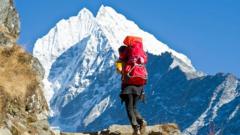With an eye toward the future, Nepal is taking significant steps to address tourism disparities by waiving climbing fees for nearly a hundred lesser-known Himalayan peaks. This initiative is set to last for two years, targeting the remote Karnali and Sudurpaschim regions, both of which are among Nepal's least developed provinces. The move comes at a crucial time as Everest's summit permit fees have increased to $15,000, the first rise in nearly a decade.
Officials from Nepal's tourism department express optimism that this new strategy will highlight the nation's less-explored travel destinations, thereby stimulating local economies. Last year, mountaineering in Nepal generated $5.9 million, with a staggering portion attributed to Mount Everest alone—notably, while just 68 climbers ventured into the 97 peaks over the last two years, a remarkable 421 were granted permits for Everest in 2024 alone.
Commenting on the plan, Himal Gautam, director of Nepal's Tourism Department, emphasized the importance of creating jobs and income through exposure to these remote areas. However, this effort raises further questions about whether adequate infrastructure will be constructed to facilitate access to these peaks and how local communities may adapt to a potential influx of climbers.
Environmental concerns and overcrowding on Everest, alongside a recent Supreme Court ruling aimed at limiting climbing permits, highlight the complexity of managing tourism and mountain access. As legislation is introduced requiring aspiring Everest climbers to have previously scaled a mountain above 7,000 meters in Nepal, it underscores the potential viability of the remote peaks as low-traffic training grounds for climbers.
The decision to waive fees for climbing these majestic yet obscure Himalayan peaks is a pioneering move for Nepal, aimed at redistributing tourist attention while enhancing the overall climbing experience in the shadow of the towering Everest.
Officials from Nepal's tourism department express optimism that this new strategy will highlight the nation's less-explored travel destinations, thereby stimulating local economies. Last year, mountaineering in Nepal generated $5.9 million, with a staggering portion attributed to Mount Everest alone—notably, while just 68 climbers ventured into the 97 peaks over the last two years, a remarkable 421 were granted permits for Everest in 2024 alone.
Commenting on the plan, Himal Gautam, director of Nepal's Tourism Department, emphasized the importance of creating jobs and income through exposure to these remote areas. However, this effort raises further questions about whether adequate infrastructure will be constructed to facilitate access to these peaks and how local communities may adapt to a potential influx of climbers.
Environmental concerns and overcrowding on Everest, alongside a recent Supreme Court ruling aimed at limiting climbing permits, highlight the complexity of managing tourism and mountain access. As legislation is introduced requiring aspiring Everest climbers to have previously scaled a mountain above 7,000 meters in Nepal, it underscores the potential viability of the remote peaks as low-traffic training grounds for climbers.
The decision to waive fees for climbing these majestic yet obscure Himalayan peaks is a pioneering move for Nepal, aimed at redistributing tourist attention while enhancing the overall climbing experience in the shadow of the towering Everest.



















